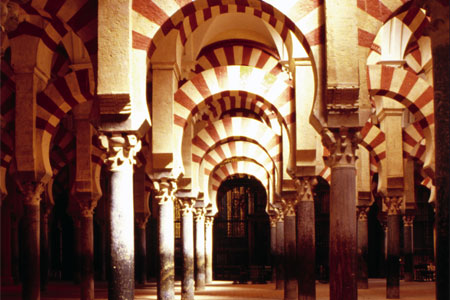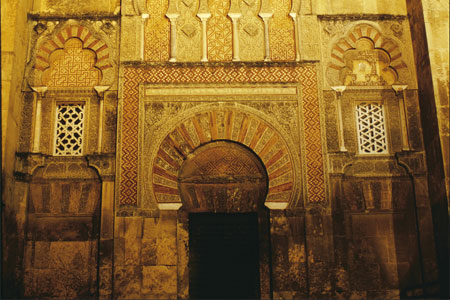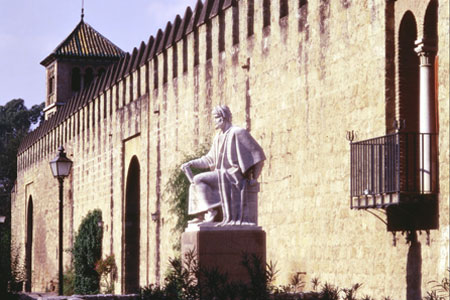
Cordoba: A Tale of Two Cities
Issue 1 Sept / Oct 2003
Mariam Rosser-Owen discovers two Cordobas. Most visitors avoid the modern city entirely, and head straight for the ‘centro histórico.’ But be prepared – the heart of historic Cordoba is small and you may find yourself in the company of many other tourists drawn by the city’s distinctive appeal. It is worth considering visiting Cordoba out of the tourist season – you will find you have the place mostly to yourself, which enhances its magic.
Spain was conquered by the Arabs in 711 AD, and they chose Córdoba as their capital. The city is located almost at the exact centre of what is today known as Andalusia, after the Arab name for Islamic Spain – al-Andalus. The earliest Arab settlers shared the worshipping space of the largest church in the city, and only after some forty years – when the Muslim population had become big enough to need its own prayer space – was the first congregational mosque built. This was the building which over the course of the next three hundred years grew into the Great Mosque of Cordoba.
Its distinctive features of horseshoe arches and two-tiered arcades owe much to the architectural traditions of Visigothic Spain. The use of mosaic decoration in the beautiful mihrab (prayer niche) constructed by the Caliph al-Hakam II (961-976 AD), harks back to the monuments of the Umayyad homeland – the Dome of the Rock, and Walid’s Mosque in Damascus. This fusion of styles and traditions encapsulates the religious and cultural tolerance and harmony that prevailed during Muslim rule in Spain.
Cordoba Guide

What To See
Though the Great Mosque is by far Cordoba’s most famous attraction, the city has many hidden gems. One such is the gardens of the Alcázar de los Reyes Católicos (Palace of the Christian Kings), built on the site of the Arab palace, just to the east of the mosque.
Wandering among the orange and lemon groves here is an enchanting experience. At sunset you will be treated to a real son et lumière show by the swallows which nest in the tree-tops and swarm as the sun goes down.
Visit the interesting and garishly restored remains of a tenth-century bath-house to the north of the mosque; the medieval water-wheel which still stands on the banks of the River Guadalquivir (named after al-Wadi al-Kabir, or ‘Great Stream’), slightly downstream from the Roman Bridge; and on the far bank, the Torre de la Calahorra – one of medieval Cordoba’s fortified gatehouses – houses a fun, interactive display detailing the city’s history.
The Museo Arqueológico Provincial tells you much about the past glories of Cordoba in the attractive setting of a Renaissance mansion. And for the visitor who likes to wander a little further afield, a short drive into the outlying countryside will take you to Madinat al-Zahra. Here lies the largest Muslim excavation site in Spain and the ruins of the palace-city of the Umayyad Caliphs of Cordoba.
The Arab love of gardens and water is evident in Cordoba today. The residents are proud of their garden-patios, which provide a haven of peace and quiet, and shade in the heat of the summer. There is an annual competition in May for the best patio, and during this time many of the entrants are open to the public (they are closed for the rest of the year). Flowers are everywhere, and geraniums pour down the walls of houses, suspended in flower pots decorated in the distinctive ceramic style inherited from the Arabs who used to live here. The trick in Cordoba is just to wander – it is easy to get lost among the many small streets which fill the barrios around the Mosque, but this is the way to discover the city’s treasures.

Where To Eat
Historic Cordoba is a quiet place at night, as the local owners of shops and cafes tend to live in the modern city, and go back there after closing time. For a quiet place to eat or drink, try the pavement cafes in the Plaza del Potro, an attractive little square lined with Renaissance mansions, in one of these Cervantes is thought to have come up with the story of Don Quixote. The recently-opened Oh La La on Calle Deanes, 11, is a good source of reasonably-priced sandwiches and pasta dishes.
The restaurants around the Great Mosque are the most atmospheric locations, though not always the cheapest. El Caballo Rojo (on Calle Cardenal Herrero, 28) specialises in food from the time of the Caliphs, and Restaurante Bandolero (Calle de Torrijos, 6) has a large covered patio at the back which provides a calm and cool retreat. In the summer it is worth visiting any restaurant near the Mosque that has seating on the roof – eating gazpacho blanco (cold almond and garlic soup) with a view of the minaret-bell tower at sunset is a memory that will stay with you for a long time.
It is always worth checking before you order whether there is ham in the food, since it is practically used as a condiment in Spanish cooking. Now that the local Muslim population is on the increase again, there is an Islamic Cultural Centre on Calle Rey Heredia, 28, whose Restaurante Cafetín Halal serves excellent and inexpensive halal food with vegetarian options.
Shopping
Other signs of the resurgence of Islamic culture in Cordoba are the growing number of craft centres which sell Arab designs embossed in leather; and the recently opened hammam (bath house) – ideal for relaxing after an intensive wander around Cordoba’s sites. The teterías, or tea-houses, specialise in halawiyat (sweet pastries) and flavoured herbal teas named after Arab towns.
Entertainment
If you still have the energy after all this for late-night entertainment, try one of Cordoba’s tablaos for a flamenco show – though these performances are put on for the tourists, they are still spectacular.
Where To Stay
By the end of the day, you will be ready to collapse into your bed – whether in one of the upmarket five-star hotels next to the Great Mosque, like the Hotel onquistador, Hotel Maimonides or Hotel Los Omeyas, or in one of the budget pensions which are often in beautiful old houses built round garden-filled patios – such as the Hostal Séneca or Hostal Rey Heredia. Any guide book will have a list of likely places, which range from the basic to the luxurious. The one thing to remember is that it is advisable to book in advance, because Cordoba is a very popular destination on the tourist trail round Southern Spain.
Getting There
EasyJet (0870 6 000 000, www.easyjet.com) has cheap deals to Malaga and Madrid from where you can take the train (www.raileurope.co.uk) to Cordoba. For further information contact the Spanish Tourist Office (020 7486 8077, www.tourspain.co.uk) This magical city deserves to have a few slow days spent here, absorbing its beautiful sites and uniquely important history. Happy travelling!
words: Mariam Rosser Owen. She holds a PhD in the Art and Architecture of Islamic Spain from the University of Oxford. She is Assistant Curator in the Middle East section of the Victoria & Albert Museum.
photography: Peters Sanders and the Spanish Tourism Board
Bookmark this |
|
Add to DIGG |
|
Add to del.icio.us |
|
Stumble this |
|
Share on Facebook |
|
Share this |
|
Send to a Friend |
|
Link to this |
|
Printer Friendly |
|
Print in plain text |
|


Comments
0 Comments